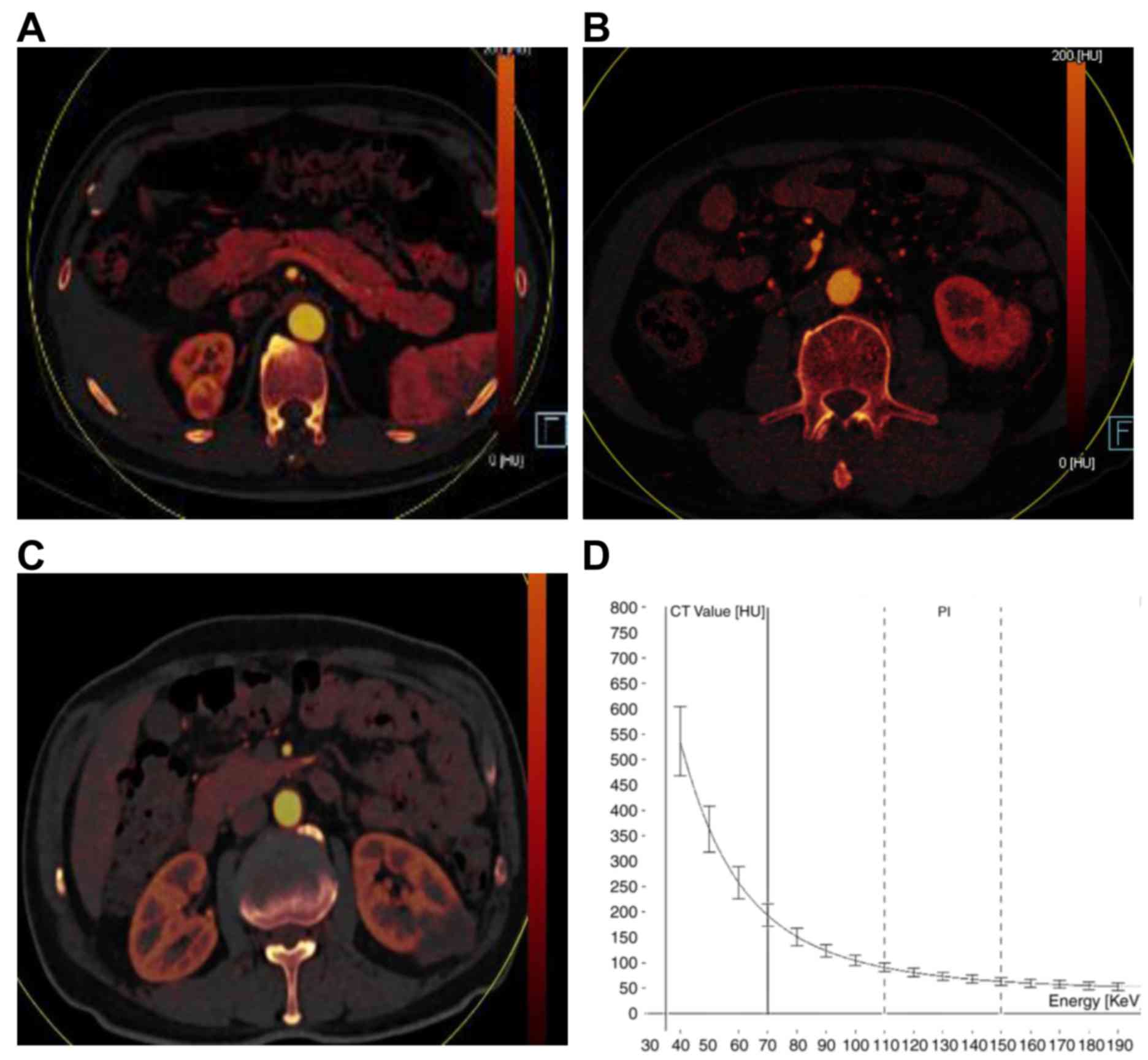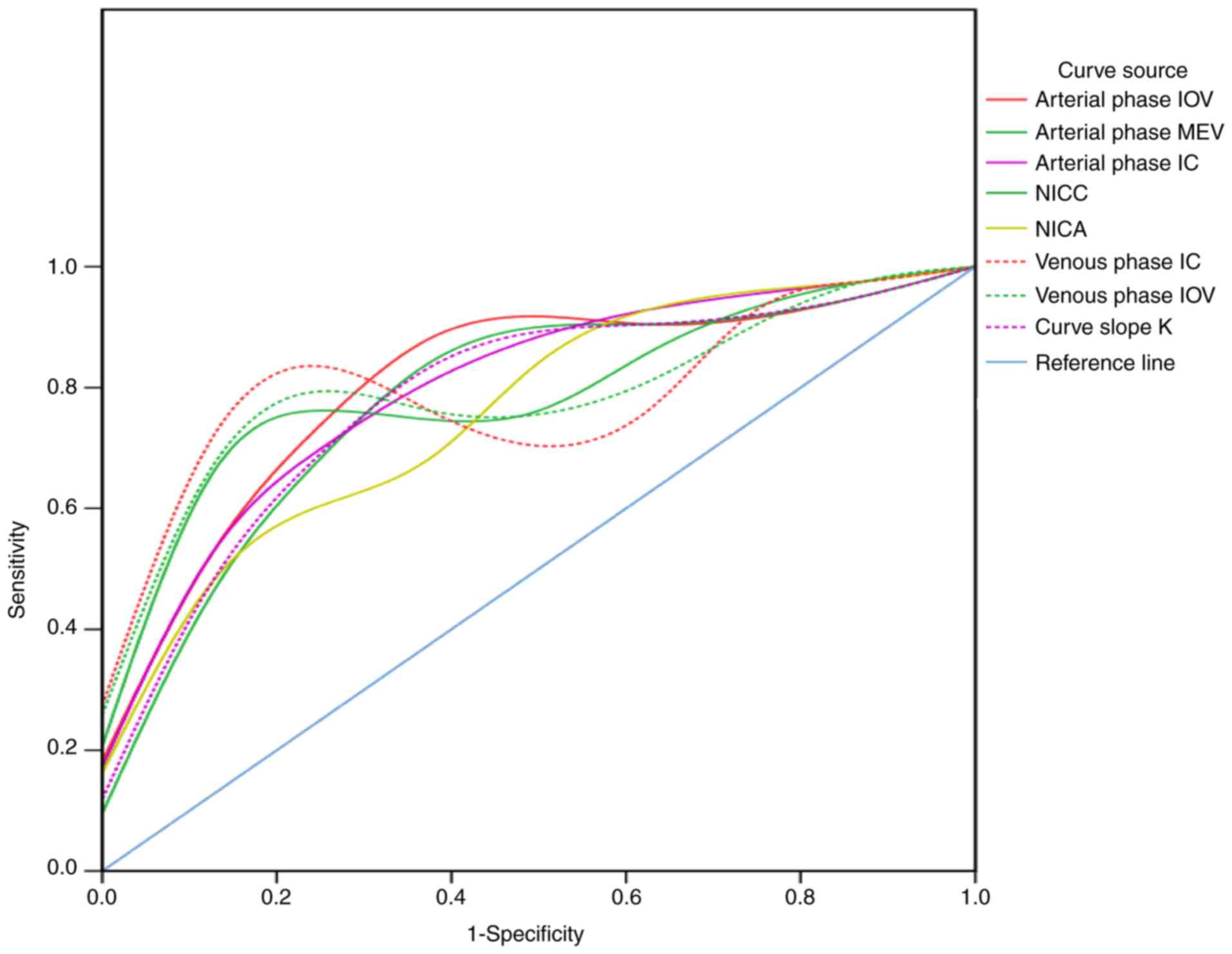|
1
|
Kim JK, Kim TK, Ahn HJ, Kim CS, Kim KR and
Cho KS: Differentiation of subtypes of renal cell carcinoma on
helical CT scans. AJR Am J Roentgenol. 178:1499–1506. 2002.
View Article : Google Scholar : PubMed/NCBI
|
|
2
|
Hu Y, Lu J, Li Y, et al: Expression level
of lncRNA CCAT2 is related with the clinical stage of RCC. Chinese
J Clin. 2015.(In Chinese).
|
|
3
|
Fuhrman SA, Lasky LC and Limas C:
Prognostic significance of morphologic parameters in renal cell
carcinoma. Am J Surg Pathol. 6:655–663. 1982. View Article : Google Scholar : PubMed/NCBI
|
|
4
|
Ljungberg B, Cowan NC, Hanbury DC, Hora M,
Kuczyk MA, Merseburger AS, Patard JJ, Mulders PF and Sinescu IC;
European Association of Urology Guideline Group, : EAU guidelines
on renal cell carcinoma: The 2010 Update. Eur Urol. 58:398–406.
2010. View Article : Google Scholar : PubMed/NCBI
|
|
5
|
Lohse CM and Cheville JC: A review of
prognostic pathologic features and algorithms for patients treated
surgically for renal cell carcinoma. Clin Lab Med. 25:433–464.
2005. View Article : Google Scholar : PubMed/NCBI
|
|
6
|
Teng J, Gao Y, Chen M, Wang K, Cui X, Liu
Y and Xu D: Prognostic value of clinical and pathological factors
for surgically treated localized clear cell renal cell carcinoma.
Chin Med J (Engl). 127:1640–1644. 2014.PubMed/NCBI
|
|
7
|
Lang H, Lindner V, de Fromont M, Molinié
V, Letourneux H, Meyer N, Martin M and Jacqmin D: Multicenter
determination of optimal interobserver agreement using the Fuhrman
grading system for renal cell carcinoma: Assessment of 241 patients
with >15-year follow-up. Cancer. 103:625–629. 2005. View Article : Google Scholar : PubMed/NCBI
|
|
8
|
Wang R, Wolf JS Jr, Wood DP Jr, Higgins EJ
and Hafez KS: Accuracy of percutaneous core biopsy in management of
small renal masses. Urology. 73:581–590. 2009. View Article : Google Scholar
|
|
9
|
Lin RF: Predictors of recurrence after
nephron-sparing surgery for renal cell carcinoma. PhD
dissertationFujian Medical University; 2017
|
|
10
|
Punjabi GV: Multi-energy spectral CT:
Adding value in emergency body imaging. Emerg Radiol. 25:197–204.
2018. View Article : Google Scholar : PubMed/NCBI
|
|
11
|
Li Z, Leng S, Yu L, Manduca A and
McCollough CH: An effective noise reduction method for multi-energy
CT images that exploits spatio-spectral features. Med Phys.
44:1610–1623. 2017. View
Article : Google Scholar : PubMed/NCBI
|
|
12
|
Zhou W, Schornak R, Michalak G, Weaver J,
Abdurakhimova D, Ferrero A, Fetterly KA, McCollough CH and Leng S:
Determination of optimal image type and lowest detectable
concentration for iodine detection on a photon counting
detector-based multi-energy CT System. Proc SPIE Int Soc Opt Eng.
10573:105734U2018.PubMed/NCBI
|
|
13
|
Choi SY, Sung DJ, Yang KS, Kim KA, Yeom
SK, Sim KC, Han NY, Park BJ, Kim MJ, Cho SB and Lee JH: Small
(<4 cm) clear cell renal cell carcinoma: Correlation between CT
findings and histologic grade. Abdom Radiol (NY). 41:1160–1169.
2016. View Article : Google Scholar : PubMed/NCBI
|
|
14
|
Coy H, Young JR, Douek ML, Pantuck A,
Brown MS, Sayre J and Raman SS: Association of qualitative and
quantitative imaging features on multiphasic multidetector CT with
tumor grade in clear cell renal cell carcinoma. Abdom Radiol (NY).
44:180–189. 2018. View Article : Google Scholar
|
|
15
|
Brown CL, Hartman RP, Dzyubak OP,
Takahashi N, Kawashima A, McCollough CH, Bruesewitz MR, Primak AM
and Fletcher JG: Dual-energy CT iodine overlay technique for
characterization of renal masses as cyst or solid: A phantom
feasibility study. Eur Radiol. 19:1289–1295. 2009. View Article : Google Scholar : PubMed/NCBI
|
|
16
|
Chandarana H, Megibow AJ, Cohen BA,
Srinivasan R, Kim D, Leidecker C and Macari M: Iodine
quantification with dual-energy CT: Phantom study and preliminary
experience with renal masses. AJR Am J Roentgenol. 196:W693–W700.
2011. View Article : Google Scholar : PubMed/NCBI
|
|
17
|
Mileto A, Nelson RC, Samei E, Jaffe TA,
Paulson EK, Barina A, Choudhury KR, Wilson JM and Marin D: Impact
of dual-energy multi-detector row CT with virtual monochromatic
imaging on renal cyst pseudoenhancement: In vitro and in vivo
study. Radiology. 272:7672014. View Article : Google Scholar : PubMed/NCBI
|
|
18
|
Sauter AP, Muenzel D, Dangelmaier J,
Braren R, Pfeiffer F, Rummeny EJ, Noël PB and Fingerle AA:
Dual-layer spectral computed tomography: Virtual non-contrast in
comparison to true non-contrast images. Eur J Radiol. 104:108–114.
2018. View Article : Google Scholar : PubMed/NCBI
|
|
19
|
McCollough CH, Leng S, Yu L and Fletcher
JG: Dual- and multi-energy CT: Principles, technical approaches,
and clinical applications. Radiology. 276:637–653. 2015. View Article : Google Scholar : PubMed/NCBI
|
|
20
|
Grajo JR, Patino M, Prochowski A and
Sahani DV: Dual energy CT in practice: Basic principles and
applications. Appl Radiol. 45:6–12. 2016.
|
|
21
|
Wang G, Zhang C, Li M, Deng K and Li W:
Preliminary application of high-definition computed tomographic
Gemstone Spectral Imaging in lung cancer. J Comput Assist Tomogr.
38:77–81. 2014. View Article : Google Scholar : PubMed/NCBI
|
|
22
|
Wei J, Zhao J, Zhang X, Wang D, Zhang W,
Wang Z and Zhou J: Analysis of dual-energy spectral CT and
pathological grading of clear cell renal cell carcinoma (ccRCC).
PLoS One. 13:e01956992018. View Article : Google Scholar : PubMed/NCBI
|
|
23
|
Hou WS, Wu HW, Yin Y, Cheng JJ, Zhang Q
and Xu JR: Differentiation of lung cancers from inflammatory masses
with dual-energy spectral CT Imaging. Acad Radiol. 22:337–344.
2015. View Article : Google Scholar : PubMed/NCBI
|
|
24
|
Weis M, Henzler T, Nance JW Jr,
Haubenreisser H, Meyer M, Sudarski S, Schoenberg SO, Neff KW and
Hagelstein C: Radiation dose comparison between 70 kVp and 100 kVp
with spectral beam shaping for non-contrast-enhanced pediatric
chest computed tomography: A prospective randomized controlled
study. Invest Radiol. 52:155–162. 2017. View Article : Google Scholar : PubMed/NCBI
|
|
25
|
Agliata G, Schicchi N, Agostini A, Fogante
M, Mari A, Maggi S and Giovagnoni A: Radiation exposure related to
cardiovascular CT examination: Comparison between conventional
64-MDCT and third-generation dual-source MDCT. Radiol Med.
124:753–761. 2019. View Article : Google Scholar : PubMed/NCBI
|
|
26
|
Kaltenbach B, Wichmann JL, Pfeifer S,
Albrecht MH, Booz C, Lenga L, Hammerstingl R, D'Angelo T, Vogl TJ
and Martin SS: Iodine quantification to distinguish hepatic
neuroendocrine tumor metastasis from hepatocellular carcinoma at
dual-source dual-energy liver. CT Eur J Radiol. 105:20–24. 2018.
View Article : Google Scholar : PubMed/NCBI
|
|
27
|
Li X, Jiang R and Wang B: Differentiation
of renal clear cell carcinoma: Evaluation with dual-source CT
iodine quantification. J Clin Radiol. 35:1542–1545. 2016.
|
|
28
|
Wei J, Zhao J, Zhang X, Wang D, Zhang W,
Wang Z and Zhou J: Analysis of dual energy spectral CT and
pathological grading of clear cell renal cell carcinoma (ccRCC).
PLoS One. 13:e01956992018. View Article : Google Scholar : PubMed/NCBI
|
|
29
|
Zhao J, Zhang P, Chen X, Cao W and Ye Z:
Lesion size and iodine quantification to distinguish low-grade from
high-grade clear cell renal cell carcinoma using dual-energy
spectral computed tomography. J Comput Assist Tomogr. 40:673–677.
2016. View Article : Google Scholar : PubMed/NCBI
|
|
30
|
Ouyang AM, Wei ZL, Su XY, Li K, Zhao D, Yu
DX and Ma XX: Relative computed tomography (CT) enhancement value
for the assessment of microvascular architecture in renal cell
carcinoma. Med Sci Monit. 23:3706–3714. 2017. View Article : Google Scholar : PubMed/NCBI
|
|
31
|
Jia ZZ, Gu HM, Zhou XJ, Shi JL, Li MD,
Zhou GF and Wu XH: The assessment of immature microvascular density
in gliomas with dynamic contrast-enhanced magnetic resonance
imaging. Eur J Radiol. 84:1805–1809. 2015. View Article : Google Scholar : PubMed/NCBI
|
|
32
|
Xiong Z, Liu JK, Hu CP, Zhou H, Zhou ML
and Chen W: Role of immature microvessels in assessing the
relationship between CT perfusion characteristics and
differentiation grade in lung cancer. Arch Med Res. 41:611–617.
2010. View Article : Google Scholar : PubMed/NCBI
|
















